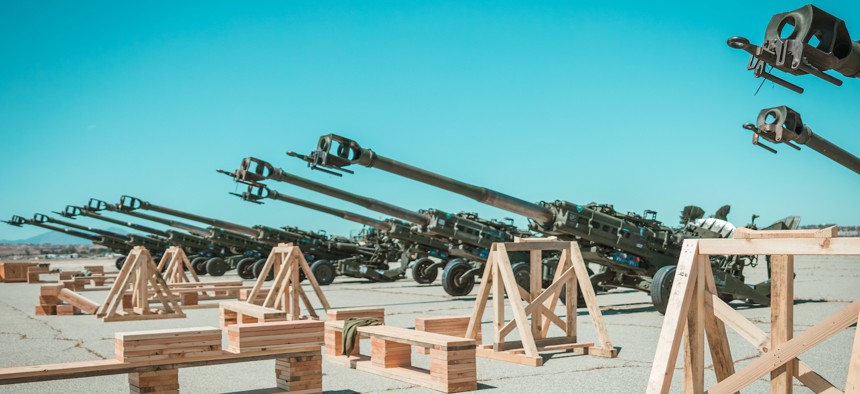
U.S. Marine Corps M777 155 mm howitzers are staged on the flight line prior to loading them into a U.S. Air Force C-17 Globemaster III aircraft to be shipped to Ukraine, April 22, 2022. U.S. Marine Corps / Staff Sgt. Royce H. Dorman
Ukraine learns to fight with a hodge-podge of foreign artillery
It's also working to protect its field guns from loitering munitions and counter-battery fire, Ukrainian officer says.
LONDON—Ukraine is methodically gathering data on its hodge-podge of Western cannons and ammunition to ensure gun crews can put fire on targets, said Lt. Col. Yurii Patskan, an officer in Ukraine’s Main Directorate of Rocket Forces and Field Artillery.
All Western howitzers given to Ukraine are of the 155mm caliber. But different countries produce shells with different quantities or propellant, which means the range charts for calculating cannon elevation may be inaccurate if a shell from one country is loaded into a gun from another. In extreme cases, the shell may not even fit in the gun. At least one Ukrainian soldier described how they were forced to manually cut down the fins of a French-supplied mortar to get it to fit in their Italian-supplied mortar tube.
To fix this problem, Ukraine has built a testing range manned by a team made up of ballistic specialists, IT workers, and a weather specialist, Patskan told Defense One on the sidelines of arms trade show DSEI.
The team works to gather data from cannons taken from the frontline with different foreign-produced amunition, then calculate what types of ballistic qualities a shell from one country has when it’s fired from a howitzer from another country.
The data is sent to Ukrainian gun crews, allowing them to confidently use ammunition from one country in cannons from another country. That way, the gun crews “are not afraid” of getting the range wrong, Patskan said.
Ukraine is also attempting to simplify logistics for its foreign-supplied weaponry by grouping it in nationally-defined units. For example, a given artillery unit may use only American M777 howitzers or Polish Krab self-propelled artillery, Patskan said.
But an even more pressing problem is the threat posed by Russian counter-battery fire and loitering munitions.
Patskan said Russian counter-battery fire could arrive within minutes of a Ukrainian howitzer blast, though it depends on the section of the front. And Russian artillery directed by drones is not as fast, he said. Russia uses a mix of capabilities to find Ukrainian artillery, including powerful radars.
Patskan also said Russian Lancet loitering munitions, which cost less than $40,000, are a threat to gun crews, whose own howitzers can cost millions of dollars. But Ukraine is using nets to catch the drones before they strike artillery.
“We can’t use our maneuverability” when the Russians use Lancet drones, Patskan said, which negates a major advantage in modern warfare and forces Ukraine to keep its guns hidden from Russian drones patrolling the sky. However, Patskan said, anti-drone guns and electronic warfare are possible defenses.
Still, amid the gleaming arms stands of DSEI, Patskan said the message of the threat of loitering munitions isn’t always getting through. One anti-drone producer he spoke to proposed using its net-firing gun to solve Ukraine's Russian drone problem, only to realize the solution is incapable of stopping a drone like the Lancet, he said.
Patskan added that Ukraine now has no issue getting new artillery barrels for its guns, which has previously been a problem due to Ukrainian gun crews wearing down barrels with fire rates far exceeding what the guns were designed for.
And Western artilleries are looking on and learning, according to a British and French officer who appeared with Patskan at a panel at DSEI.
Britain must learn to “operate in digital darkness,” said British Brigadier Neil Budd, referring to the ability of adversaries to monitor, locate, and jam troops with electronic warfare.
“To think that we're just going to walk in and be able to do what we want, and exploit all our digital systems upfront, I think is naive.”




